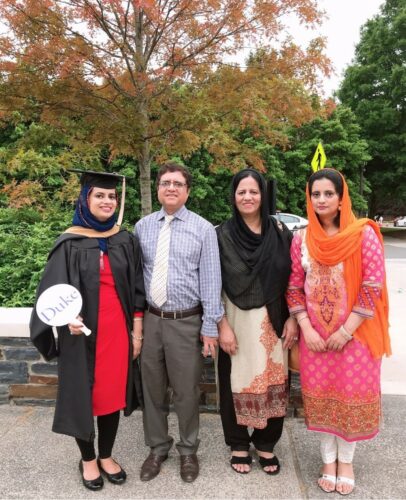Q: When you were a child, what was your response to this question: “What do you want to be when you grow up?”
A: My interests always changed with time. During elementary school, I had a deep passion for teaching. I had a mini-classroom set up at my home, where I used to pretend play teacher with my imaginary students. There was also a time when I wanted to be a fashion designer, but that desire waned, and my growing fondness for physics and mathematics inclined me toward engineering.
Q: Share the pivotal moment in your life that helped you choose your field of study.
A: During my senior year of college, I was studying telecommunication engineering, so the standard practice was to work on software-defined radios, antennas design, and wireless communication systems — which never fascinated me. In a quest for a different and unique project, I found one related to medical image processing. I began working with brain MRI scans, the enigmatic architecture of which intrigued me. I always wondered how the brain assembles its many structures to perform myriad tasks in a manner that is seamless to the outside world. And I realized that we need to develop computational tools that advance neuroscience to uncover the complex organization and functioning of the brain.

Sahar (right) with her parents at her sister’s graduation from Duke University.
Q: Tell us about a time you encountered a tricky problem. How did you handle it and what did you learn from it?
A: My PhD research focused on brain MRI registration, an image-processing method that aligns multiple images. My advisor suggested that I model the brain’s nonlinear deformations as waves, a problem I tried to solve by developing different models. But none of them worked. Later, I discovered an article that I felt related to the problem and started to study the wave model in depth, incorporating it into my research. After putting a lot of effort in formulating the method — 18 months to be exact — it eventually worked. Overall, this journey from failure to success developed persistence in me.
Q: Describe your research in 5 words.
A: Brain voyage: cradle to grave.
Q: What are your passions outside of research?
A: I am obsessed with cleaning and organizing my home. I like to clear clutter and put everything in place. Being organized gives me peace of mind and increases my productivity. It also extends into my research: It helps me meet deadlines and accomplish daily tasks. Besides organization, I also like to bake, watch thriller and comedy movies, and play puzzle video games.


